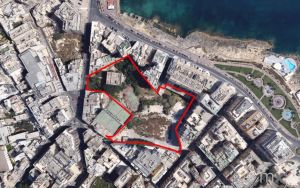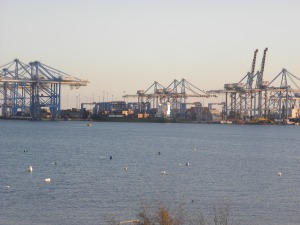On the 14 September the Planning Authority approved application PA3487/19 which proposed the “stabilization of dangerous rock slope; repair to deteriorated concrete wall and construction of wave dissipation slope along the Qui Si Sana coastline”.
In simple language this involves a permit for remedial works after a cave along the Sliema Qui Si Sana coastline collapsed, thereby exposing the MIDI development works immediately behind the cave: the basement level of residential blocks T14 and T17.
We have been told that the cave collapsed as a result of erosion along the coastline. Some readers may tend to forget that way back in 2016, a Maltese geologist had sounded the alarm that a “high-rise had been constructed over a fractured and eroded sea cliff, which could collapse any time soon.” The collapse in fact occurred relatively quite soon, signifying that the geologist was pointing out the obvious which was being ignored or not given due consideration by the developer and his advisors.
The point to be made is why the Planning Authority permitted the development to take place so close to the coastline. As far as I am aware, the EIA relative to the Tigne Development by MIDI does not reveal any detailed studies on the condition of the coast as well as on the impacts of erosion on the Qui Si Sana coastline and its relevance to the development of the MIDI project. The issue is not just one of remedial works but on why the Planning Authority ignored the state of the coast, as a result permitting development too close to the coastline for comfort. The collapse is adequate proof of all this. The Planning Authority has much to explain in this specific case. Its actions, or lack of them, should be investigated.
The issue is not one relative to the structural stability of the development but of the protection of the coastline.
Erosion as a result of natural elements occurs continuously. It is a natural ongoing phenomenon.
In this respect it may be pertinent to draw attention to a report, authored by a team of geologists, dated October 2007 and entitled : “Report on Coastal Sliema. Geology, geomorphology, sites of scientific interest and coastal protection considerations.” This report was commissioned by the Sliema Local Council.
The 50-page report, which makes interesting reading, emphasises that a number of sites along the Sliema coast “are undergoing rapid coastal erosion that will increase with climate change, resulting in instability or failure in coastal infrastructure.”
Of particular interest is that the report, authored in 2007, goes on to state that “The faulted coast along Għar id-Dud is retreating rapidly by dislodgement of boulders along joints and faults. Public structures that may be affected include Tower Road promenade. The Għar id-Dud cave may also partially or totally collapse, leading to the caving-in of the overlying pedestrian promenade. If collapse is sudden and during daytime/early night time, injury and loss of lives may result.”
I have personally drawn attention of the Transport Minister to the above some time ago, however to date I am not aware that any action has been taken.
The matter was already very worrying way back in 2007 and most probably it is even worse now, after thirteen years, given that no coastal protection works have been taken in hand in the area in the intervening period.
The Għar id-Dud cave is the result of natural erosion and collapse accelerated by wave action. This is a natural process that cannot be halted unless adequate coastal protection works are initiated. If nature is left on its own, the end result is quite predictable: a complete collapse of Għar id-Dud, a caving in of the overlying pedestrian promenade and a number of dead or injured pedestrians, depending on the time of day when a collapse possibly occurs.
Will Transport Malta and the other authorities wake up from their slumber and act immediately please?
published in The Malta Independent on Sunday: 27 September 2020


